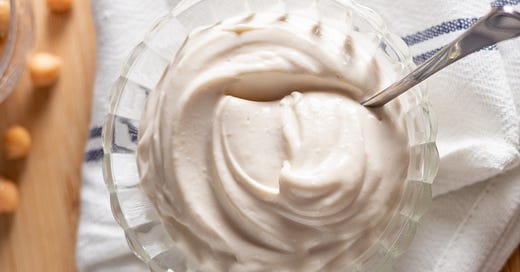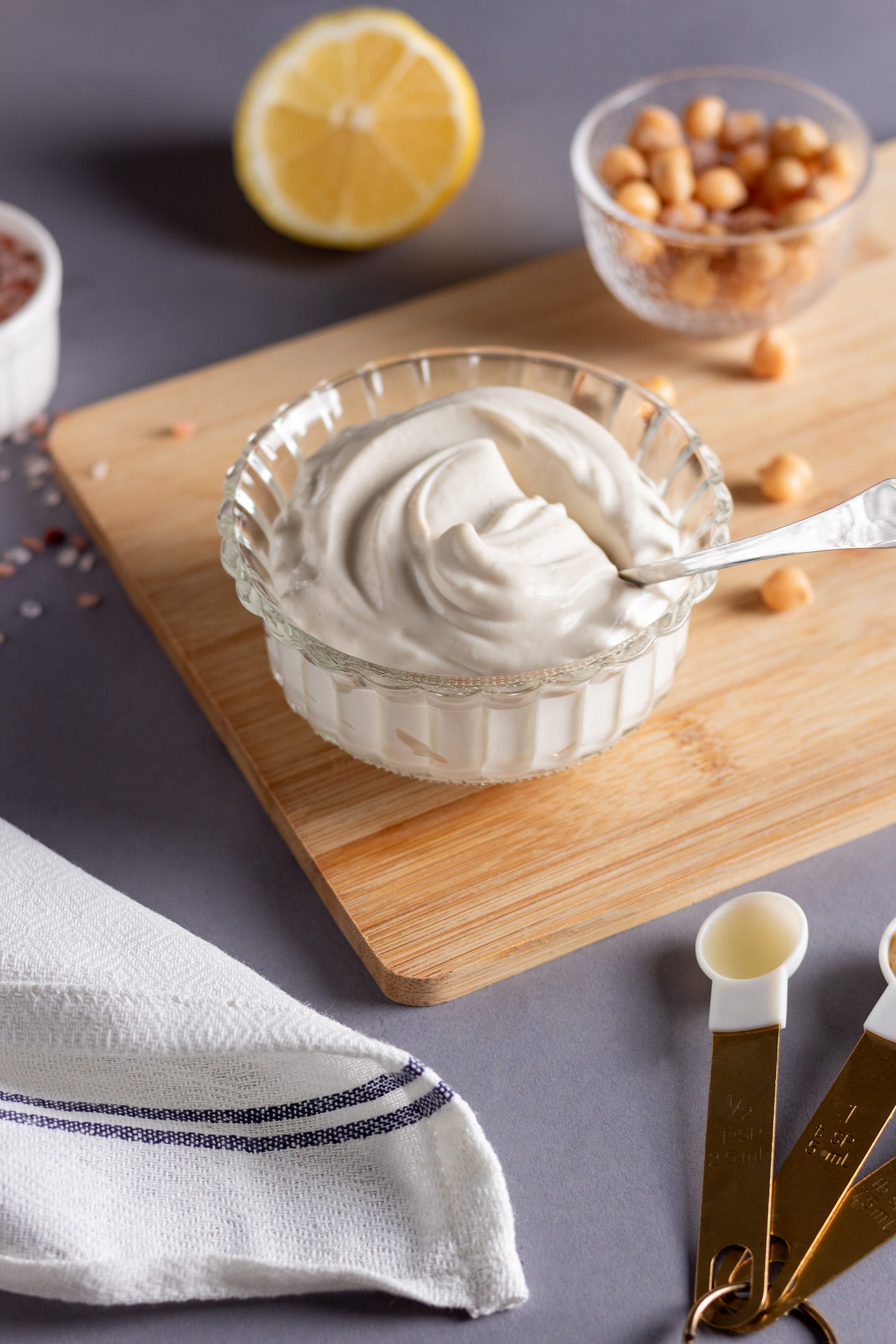Plant-Based Mayo (Nut-Free, Soy-Free)
Creamy mayonnaise made with aquafaba—the liquid from a can of chickpeas
The Story Behind the Dish
A few weeks ago, I made mayonnaise from scratch for the first time. Inspired by Alice Waters’ MasterClass, where she whisked up a batch by hand, I decided to give it a try. Watching egg yolks and oil slowly come together into a creamy, velvety spread felt satisfying. It was one of those things that seemed to happen slowly and then all at once. As fascinating as the process was, I wasn’t thrilled about eating raw eggs. That led me to look into plant-based alternatives, and I learned about aquafaba, the liquid from cooked chickpeas. It works well as an egg-free substitute, and my first attempt at aquafaba mayo turned out perfectly! It tasted just like traditional mayonnaise. I was shocked.
Of course, I learned the hard way that emulsification has its rules. On round two, I threw caution (and proper technique) to the wind. Instead of the steady stream of oil the process requires, I dumped it all in at once. This will be fine, I thought. Spoiler: it wasn’t. What I ended up with was a runny, sad mess that looked like melted whipped cream.
Determined to get it right, I tried again. This time, I poured the oil in slowly, but it still wouldn’t mix. Frustrated, I turned to Reddit for advice, just like I did with my Lemon Granola recipe, and found some helpful tips: reduce the aquafaba by simmering it and blend in a few chickpeas.
Here’s what I later learned about the science: aquafaba and egg yolks contain special proteins that act as mediators between oil and water, helping them combine into a smooth, stable emulsion. These proteins have unique structures that let them cling to both oil and water, creating a bridge that keeps everything together. Slowly adding oil and whisking steadily gives these protein "bridges" time to wrap around each tiny oil droplet, evenly spreading them throughout the mixture and creating a creamy texture. Without these protein mediators, the oil and liquid would stubbornly refuse to mix, no matter how vigorously you whisk.
Simmering the aquafaba concentrates its proteins, making them more effective at creating a stable emulsion, while blending in chickpeas adds extra emulsifiers. With these changes, the aquafaba mayonnaise finally came together perfectly! The little kitchen mishaps made me appreciate the process even more. When done right, aquafaba mayo is rich, creamy, and dare I say, even more satisfying than the classic version. It’s a bit of kitchen chemistry that turns ingredients that don’t naturally mix into something cohesive and delicious. If you’re curious about the science of cooking, I highly recommend On Food and Cooking: The Science and Lore of the Kitchen by Harold McGee.
Aquafaba mayo is nut-free, soy-free, and completely plant-based, making it a great option for those with dietary restrictions or allergies. It’s versatile and delicious. I’ve been experimenting with ways to use it in recipes and can’t wait to share them with you soon!
Recipe Overview
Prep Time: 5 minutes
Cooking Time: 20 minutes
Yields: About ½ cup of aquafaba mayo
Ingredients
½ cup aquafaba (liquid from a can of chickpeas; reduces to about ¼ cup after simmering)
1 tablespoon chickpeas (from the same can as the aquafaba)
¾ cup neutral oil (such as avocado oil)
½ teaspoon Dijon mustard
1 teaspoon fresh lemon juice (or apple cider vinegar)
¼ teaspoon salt (adjust to taste)
Directions
Reduce the aquafaba: Pour the aquafaba into a small saucepan and bring it to a gentle simmer. Let it simmer until reduced to about ¼ cup. It should take roughly ten minutes. Keep an eye on it to avoid evaporating too much liquid (or all of it…I’ve done that).
Froth the aquafaba: Transfer the reduced aquafaba to a wide-mouthed jar. Insert an immersion blender so it touches the bottom of the jar, and blend until the aquafaba becomes frothy.
Add the flavorings: Add the tablespoon of chickpeas, Dijon mustard, lemon juice (or apple cider vinegar), and salt. Blend until the mixture is smooth and well combined.
Add the oil SLOWLY: With the immersion blender running, drizzle the oil into the jar in a very thin stream or even as droplets. Add more oil only after the previous amount is fully incorporated. You’ll see the mixture thicken as it emulsifies. Keep the blender near the bottom of the jar for stability, moving it up and down occasionally to incorporate air.
Finish Blending: Once all the oil is added and the mixture is thick and creamy, lift the blender slightly to ensure everything is fully incorporated. The entire process of adding oil typically takes me about 10 minutes.
Taste and adjust: Taste the aquafaba mayo and adjust the seasoning as needed, adding more salt, mustard, or vinegar for flavor balance. Since the aquafaba was heated, the mayo will initially be warm and slightly thinner. Transfer it to the fridge and let it chill for at least an hour to thicken and cool fully before serving.
Nutrition Overview
The nutritional values below are calculated using Cronometer and are for 1 tablespoon (1/8 of the recipe).
Calories: 148
Protein: 0 g
Fiber: 0 g
Net Carbs: 0.6 g
Fat: 16 g
Hope you enjoy this recipe! Let me know how it turns out or share any emulsifying tips you’ve learned. I’d love to hear from you!
Take care,
Rebecca





Love this! I actually recently tried a new brand that makes plant-based dips and mayos using aquafaba and I was seriously impressed at how tasty they were! I’ll have to try making mayo on my own sometime